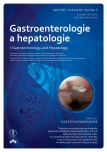Trombotic microangiopathy – a nephrologists‘ view
Authors:
J. Vachek 1; O. Zakiyanov 1; V. Motáň 2; V. Tesař 1
Authors‘ workplace:
Klinika nefrologie 1. LF UK a VFN v Praze
1; Transfuzní oddělení, Oddělení klinické hematologie, Nemocnice České Budějovice a. s.
2
Published in:
Gastroent Hepatol 2015; 69(3): 262-266
Category:
Chapters from Internal Medicine: Case report
doi:
https://doi.org/10.14735/amgh2015262
Overview
Thrombotic microangiopathy (TMA) is a syndrome characterised by haemolytic anaemia with fragmented red blood cells (schistocytes) in peripheral blood, thrombocytopenia caused by increased platelet aggregation and consumption, resulting in a disturbance of microcirculation caused by a formation of microthrombi. Vascular occlusion causes tissue and organ ischaemia that results in functional disorders of various organs, mainly the central nervous system, kidneys, heart, lungs and gut. Idiopathic TMAs include two etiologically distinct categories known as thrombotic thrombocytopenic purpura and haemolytic uremic syndrome. Secondary TMAs may be caused by certain drugs, infections, malignancies, systemic diseases, or associated with pregnancy. TMA is a rare disease; the reported incidence rates of idiopathic TMA range from one to four patients per million persons year. However, due to the heterogeneity of clinical symptoms, any physician can come across patients suffering from TMA. Timely diagnosis and appropriate treatment are crucial for the outcome of the patients, otherwise the affected patients are threatened with rapid progressive decline of vital functions. This article aims to provide a brief overview of thrombotic microangiopathies and highlights certain novel diagnostic and therapeutic approaches. In addition, the article helps increase general awareness of these diseases, specifically in view of possible difficulties in diagnosis and classification of clinical categories of TMAs.
Key words:
haemolytic uremic syndrome – thrombotic thrombocytopenic purpura – thrombocytopenia – haemolytic anaemia – plasma exchange – eculizumab
The authors declare they have no potential conflicts of interest concerning drugs, products, or services used in the study.
The Editorial Board declares that the manuscript met the ICMJE „uniform requirements“ for biomedical papers.
Submitted:
10. 6. 2015
Accepted:
17. 6. 2015
Sources
1. Nangaku M, Nishi H, Fujita T. Pathogenesis and prognosis of thrombotic microangiopathy. Clin Exp Nephrol 2007; 11(2): 107– 114.
2. Tsai HM. Current concepts in thrombotic thrombocytopenic purpura. Ann Rev Med 2006; 57: 419– 436.
3. Adler M, Kremer Hovinga JA, Lämmle B. Thrombotic thrombocytopenic purpuran – an often missed diagnosis. Rev Med Suisse 2014; 10(452): 2280– 2284.
4. Legendre CM, Licht C, Muus P et al. Terminal complement inhibitor eculizumab in atypical hemolytic-uremic syndrome. N Engl J Med 2013; 368(23): 2169– 2181. doi: 10.1056/ NEJMoa1208981.
5. Bennett CL, Weinberg PD, Rozenberg-Ben-Dror K et al. Thrombotic thrombocytopenic purpura associated with ticlopidine. A review of 60 cases. Ann Intern Med 1998; 128(7): 541– 544.
6. Knoebl P. Blood coagulation disorders in septic patients. Wien Med Wochenschr 2010; 160(5– 6): 129– 138. doi: 10.1007/ s10354-009-0738-9.
7. Merayo-Chalico J, Demichelis-Gómez R, Rajme-López S et al. Risk factors and clinical profile of thrombotic thrombo-cytopenic purpura in systemic lupus erythematosus patients. Is this a distinctive clinical entity in the thrombotic microangiopathy spectrum?: a case control study. Thromb Res 2014;134(5): 1020– 1027. doi: 10.1016/ j.thromres.2014.09.005.
8. Scheiring J, Rosales A, Zimmerhackl LB. Clinical practice. Today’s understanding of the haemolytic uraemic syndrome. Eur J Pediatr 2010; 169(1): 7–13. doi: 10.1007/ s00431-009-1039-4.
9. Khandelwal P, Gupta A, Sinha A et al. Effect of plasma exchange and immunosuppressive medications on antibody titers and outcome in anti-complement factor Hantibody-associated hemolytic uremic syndrome. Pediatr Nephrol 2015; 30(3): 451– 457. doi: 10.1007/ s00467-014-2948-7.
10. Delmas Y, Vendrely B, Clouzeau B et al. Outbreak of Escherichia coli O104:H4 haemolytic uraemic syndrome in France: outcome with eculizumab. Nephrol Dial Transplant 2014; 29(3): 565– 572. doi: 10.1093/ ndt/ gft470.
11. Cullinan N, Gorman KM, Riordan M et al. Case report: Benefits and challenges of long-term eculizumab in atypical hemolytic uremic syndrome. Pediatrics 2015; 135(6): e1506– e1509. doi: 10.1542/ peds.2014-3503.
Labels
Paediatric gastroenterology Gastroenterology and hepatology SurgeryArticle was published in
Gastroenterology and Hepatology

2015 Issue 3
Most read in this issue
- Saccharomyces boulardii – probiotic yeast from Indochina
- Recommendation of surgical treatment in patients with inflammatory bowel diseases – part 2: Crohn´s disease
- Trombotic microangiopathy – a nephrologists‘ view
- Groove (paraduodenal) pancreatitis – a case series of six patients
